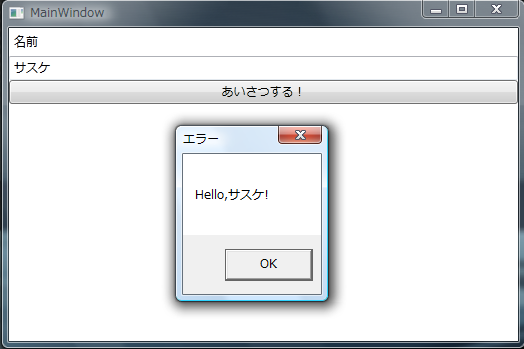はじめに
前回、Messenger パターンという、ViewModel から View に要求を送る方法を試しました。
ただ、「View のコードビハインドにメッセージを処理するコードなんて書きたくない!」っていう人は結構いるみたいです。私もできることならコードビハインド書きたくないですね。
そんな人向けに、「Blend SDK に含まれている System.Windows.Interactivity.dll を使って、メッセージに対する処理を XAML で書いてしまおう」という、 Messenger を発展させたパターンがありました。その名も「Messenger + Behavior パターン」。
Messenger + Behavior パターンの鍵
System.Windows.Interactive.dll で提供されている Interaction クラスが重要。こいつは DependencyObject の派生クラスにトリガーやビヘイビアを設定するための添付プロパティを提供しています。
簡単に言うと、Interaction クラスを使って、メッセージに対する処理(振る舞い)を、View に添付プロパティとして設定しちゃおう、ってことです。
Messenger + Behavior パターンを実装してみます
今回も MVVM Light Toolkit を使います。ダウンロードはこちら。
Blend SDK はここからダウンロードできます。Expression Blend 買わなくてもできるよ!
MVVM Light Toolkit には System.Windows.Interactive.dll が同梱されているので、それを使ってもいいです。
まず Messenger に反応するトリガーを実装します
ViewModel が送信した DialogMessage に反応して、何かアクションを実行するトリガーです。
using System.Windows; using System.Windows.Interactivity; using GalaSoft.MvvmLight.Messaging; namespace MvvmLightSample { // Messenger が DialogMessage を受信したときに反応するトリガー。 public class DialogMessageTrigger : TriggerBase<DependencyObject> { protected override void OnAttached() { base.OnAttached(); // DialogMessage を受信したらアクションを実行 // AssociatedObject は添付プロパティでこのトリガーを設定したオブジェクト。 Messenger.Default.Register<DialogMessage>( AssociatedObject, msg => InvokeActions(msg)); } protected override void OnDetaching() { Messenger.Default.Unregister<DialogMessage>(AssociatedObject); base.OnDetaching(); } } }
MessageBox を表示するアクションを実装します
DialogMessage を受け取って、MessageBox を表示するアクションです。先ほど作成した DialogMessageTrigger と組み合わせて使います。
using System.Windows; using System.Windows.Interactivity; using GalaSoft.MvvmLight.Messaging; namespace MvvmLightSample { // MessageBox を表示するアクション public class ShowMessageBoxAction : TriggerAction<DependencyObject> { protected override void Invoke(object parameter) { // DialogMessage を渡されたら // MessageBox を表示する var msg = parameter as DialogMessage; if (msg != null) { var result = MessageBox.Show( msg.Content, msg.Caption, msg.Button, msg.Icon, msg.DefaultResult, msg.Options); msg.Callback(result); } } } }
View を実装します
作成したトリガーとアクションを、Interaction クラスを使って View に設定します。これで ViewModel から DialogMessage を送信されると、この View が MessageBox を表示するようになりました。
<Window x:Class="MvvmLightSample.MainWindow" xmlns="http://schemas.microsoft.com/winfx/2006/xaml/presentation" xmlns:x="http://schemas.microsoft.com/winfx/2006/xaml" xmlns:i="clr-namespace:System.Windows.Interactivity;assembly=System.Windows.Interactivity" xmlns:l="clr-namespace:MvvmLightSample" Title="MainWindow" Height="350" Width="525" DataContext="{StaticResource MainViewModel}"> <!--ViewModel が送った DialogMessage を受信したら MessageBox を表示--> <i:Interaction.Triggers> <l:DialogMessageTrigger> <l:ShowMessageBoxAction/> </l:DialogMessageTrigger> </i:Interaction.Triggers> <StackPanel> <Label Content="名前"/> <TextBox Text="{Binding Path=Name, UpdateSourceTrigger=PropertyChanged}"/> <Button Content="あいさつする!" Command="{Binding Path=GreetCommand}"/> </StackPanel> </Window>
あと、コードビハインドには何も書いていません。
ViewModel は前回のものをそのまま流用
MVVM Light Toolkit が提供している Messenger パターンの実装を利用して、ViewModel から View にダイアログの表示をリクエストしています。
using System.Windows.Input; using GalaSoft.MvvmLight; using GalaSoft.MvvmLight.Command; using GalaSoft.MvvmLight.Messaging; namespace MvvmLightSample { public class MainViewModel : ViewModelBase { public MainViewModel() : base(Messenger.Default) { } private string _name; // 名前。 public string Name { get { return _name; } set { if (_name != value) { _name = value; RaisePropertyChanged("Name"); } } } private ICommand _greetCommand; // 挨拶コマンド。 public ICommand GreetCommand { get { return _greetCommand ?? (_greetCommand = new RelayCommand(GreetCommandExecute, CanGreetCommandExecute)); } } // 挨拶コマンドの実行。 private void GreetCommandExecute() { string greet = string.Format("Hello,{0}!", Name); MessengerInstance.Send(new DialogMessage(this, greet, result => { // MessageBos を表示した後の処理をここに書く Name = string.Empty; })); } // 挨拶コマンドを実行できるか判定。 private bool CanGreetCommandExecute() { return !string.IsNullOrEmpty(Name); } } }
App も前回のをそのまま流用
ViewModel のインスタンスを App のリソースとして持たせています。
<Application x:Class="MvvmLightSample.App" xmlns="http://schemas.microsoft.com/winfx/2006/xaml/presentation" xmlns:x="http://schemas.microsoft.com/winfx/2006/xaml" xmlns:local="clr-namespace:MvvmLightSample" StartupUri="MainWindow.xaml"> <Application.Resources> <local:MainViewModel x:Key="MainViewModel"/> </Application.Resources> </Application>






